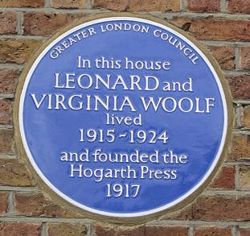
Their first publication, the first product of their printing labors, was a chapbook of their own fiction entitled Two Stories. Typesetting it was a slow, meticulous, painstaking affair: each line needed to be set, letter by letter and word by word; the type would then have be lined up to fill the width of the composing stick; and once an entire page was typeset, the block of lead pieces would have to be compressed so tightly in the frame that none of the words would fall out when the page was carried over to the handpress, which lay on the dining room table; finally, the press would have to be inked evenly enough so that, from page to page, the printing was neither too thick nor too thin.

Within six years, Virginia was adept enough at the craft to elegantly typeset, print and publish 450 copies of T.S. Eliot’s monumental poem The Wasteland, and two years after that several hundred copies of her own full-length novel, Mrs. Dalloway. A few years and dozens of titles later, the running of Hogarth Press would be given over to other hands and expand into a more traditional publishing company. But while Hogarth Press remained a tangible presence on the dining room table of the Woolfs’ ramshackle house in a London suburb, it was Virginia’s means to fulfillment, the kind of fulfillment that comes from exercising a hands-on practical skill.
Creating the actual unit copies of her press’s titles wasn’t fulfilling for Virginia only on a visceral level—it also affected in the profoundest terms how she came to consider writing and editing of course, but also the circulation of literature in general. It’s here, I think, where Hogarth Press and our press find their common ground. The new publishing technology has made it infinitely easier to create an aesthetically pleasing, readable publication—such as the one you’re reading now—and also to circulate it in forms never before conceived. As PDFs, Cantaraville as well as our ebooks can be read online, or downloaded and read offline at a reader’s leisure—even, at a reader’s leisure, printed out partially or entirely. The beauty of the page remains, whether on the screen or on paper.
With such ease of manufacture available, the selection and editing of works submitted to us can now take its rightful place at the top of our priorities. And as editors of Cantaraville-Cantarabooks, we find ourselves in the most luxurious position of all: having the means and leisure to be able to communicate, to enter the Great Literary Dialogue, with writers all over the world.
Get an Editorial Review | Get Amazon Sales & Reviews | Get Edited | Get Beta Readers | Enter the SPR Book Awards | Other Marketing Services






















Leave A Comment